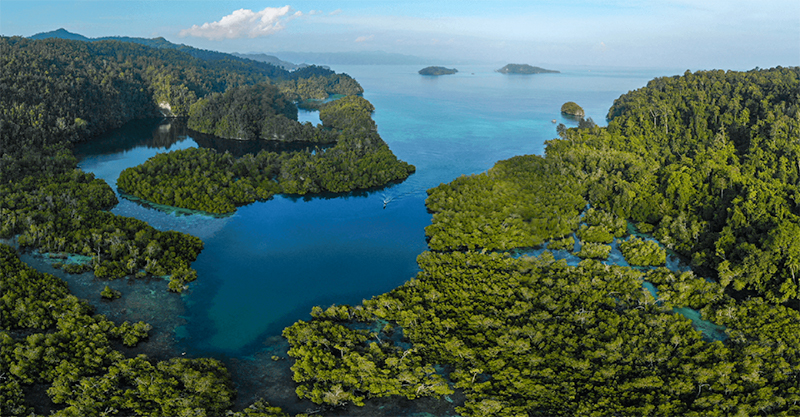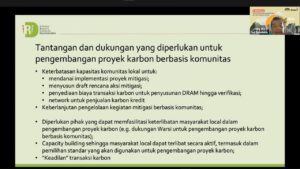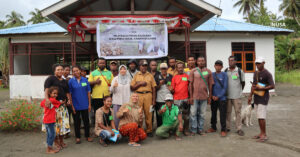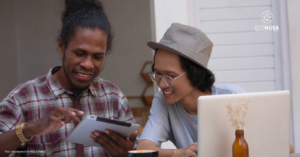
Raja Ampat in West Papua Province is a paradise for tourists. Besides having a beautiful natural landscape, the potential of Raja Ampat marine biodiversity is very high. However, the limited knowledge of the people in Raja Ampat has an impact on the minimal utilization of natural potential there. The community has not yet explored the potential that exists to support their lives.
One potential area is Manyaifun Village. This remote village in Waigeo Barat Kepulauan Subdistrict, Raja Ampat Regency has beautiful natural scenery, biological diversity in the sea is unmatched, and there we can find typical animals of Raja Ampat waters, namely Manta Rays.
There are also Friwen and Yenbeser villages located in the South Waigeo District, which has a mangrove forest. What distinguishes the mangrove forests or mangroves of this region with other regions, mangrove forests here have good conditions and authenticity is still maintained.
Unfortunately, with so much potential, the Raja Ampat community does not have adequate knowledge about the potential of their own territory. This lack of knowledge is partly due to the location of remote areas and uneven attention from various parties including the government which focuses more on tourism development.
Seeing this condition, Econusa cooperated with the community to conduct training to contribute to the development of West Papua.
Manyaifun Village
The first is an environmentally friendly homestay (lodging) management training for Manyaifun Village by utilizing sago trees. “To make a homestay, approximately 50 sago trees are needed. Unfortunately, the use of sago palm forests in large quantities has not been matched by replanting by the community, “Kris said as the Chairperson of the Raja Ampat Indigenous People and Livelihood Association Association (Pejampat).
This homestay management training introduces the public about the standard standards of homestay governance, including the importance for residents who run a homestay business to have an environmental permit and to conserve the environment and sago forests.
Socialized standards, such as carrying out separation and management of organic and inorganic waste, weekly actions to clean up the environment, and provision of final waste bins in the village.
There is also souvenir production training. This training aims to improve the family economy based on forestry. In this training there are two groups of activities, making senate (mat) and making cooking oil from village coconuts.
This activity is focused on the mama-mama group in Manyaifun village. The group of fathers helped a little in the process of taking basic materials. According to Kori, one of the senate craftsmen in Manyaifun, there were several obstacles encountered in this training. For example the process of taking materials. “The place of picking up materials varies in distance, some are close by, but some are far away. The tools used are still lacking, such as for the management of oil, coconut shredded machines, and others, “said Kori when met at his home.
The community seems enthusiastic to join this training. Although the process of planting to growth requires a very long time, the community still patiently follows each process. Good collaboration between the management and group members makes the community of landowners happy to plant.
Friwen and Yenbeser villages
For the Friwen and Yenbeser Villages, a mangrove forest utilization training was conducted by the Raja Ampat Coastal Society. They collaborated with the Gorontalo Natural Resources Management (JAPESDA) Advocacy Network and Friends of the Kalimantan Coastal Community (Sampan) to train local communities.
A total of 16 types of true mangroves (according to Kitamura et al 2003, true mangroves can live in silt in tidal areas and are able to remove excess salts from their bodies) and 29 types of associated mangroves (mangroves that are able to adapt to ecosystems but are unable to remove excess salinity) from his body) scattered throughout the study area within the boundaries of the two villages namely Friwen and Yenbeser have been identified with the community. They gained knowledge about mapping the types and uses of mangroves from the types of mangroves identified in the village. This is a map of the first mangrove species produced in Raja Ampat.
Mapping the types of mangrove forests will be a reference for the community, tourists, and the government to find out mangroves that can be processed into food or other materials that have the potential to improve the community’s economy. Through the training provided, the community gained knowledge in processing mangroves so that they could be used as syrup, flour, sticks, compote, sponge, dodol, scrub, powder, and others.
Before there was training, the Friwen and Yenbeser communities only took Rhizophora young mangrove wood, and Ceriops tagal for firewood needs. Not only is the mangrove wood used for fuelwood needs, but there are some that are sold to neighboring villages for the basic needs of lodging.
In fact, many neighboring villagers come to the mangrove area of Gam Island to cut down the Ceriops Tagal and Rhizophora spp mangroves in the villages of Friwen and Yenbeser for their firewood needs.
Mangrove forests in Raja Ampat Regency at this time are still very well preserved authenticity, but it is feared that with the increasing rate of population growth and development development, especially homestay development, massive land clearing can occur without regard to its ecological aspects. “So, through this training we also provide intensive assistance to community groups through capacity building. For example, training of conservation cadres, training of mangrove fruit processing, and initiating policies at the village level to encourage the formation of Village Forests, “said Steve as Chairman of the Raja Ampat Coastal Association.







